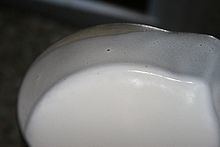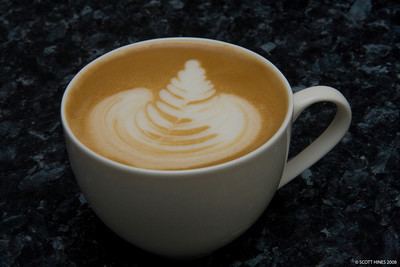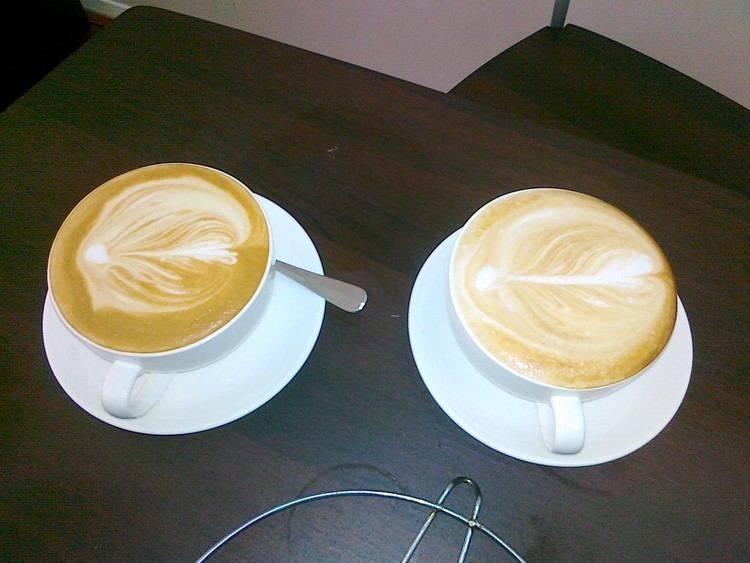 | ||
Similar Flat white, Doppio, Ristretto, Caffè crema, Latte | ||
Microfoam and latte art pour
Microfoam is milk foamed using a steam wand on an espresso machine, used for making espresso-based coffee drinks, particularly those with latte art.
Contents

The opposite of microfoam is macrofoam (also called dry foam, in contrast to the wet foam of microfoam), which has visibly large bubbles, a style of milk commonly used for cappuccinos.
Applications

The primary application of microfoam is in making latte art – patterns in espresso-based drinks – and is essential for this. Latte art is traditionally associated with lattes (drinks of 240ml or more), as the name suggests, but can also be used in shorter drinks. If cappuccino-sized (150-180ml), this is sometimes known as a "wet" cappuccino, and latte art can also be made even in the small macchiato.

Microfoam may also be added to brewed coffee in a café au lait, and faint latte art can be produced. Microfoam may also be used in a steamer, though this can instead be made with dry foam.
By contrast, microfoam is not necessary for "dry" cappuccinos, which instead have a layer of dry foam floating on top, nor is it necessary or generally used in latte macchiatos, which also typically have separate layers of dry foam and liquid milk.
As producing microfoam, and a fortiori latte art, requires a skilled barista, it is a sign of attention to quality, and a defining characteristic of the third wave of coffee.
Procedure

Creating steamed milk requires the introduction of steam to the milk until a certain amount of foam (also called "froth") is created.
The foam content is controlled by the barista during the steaming process, and involves two phases: first, introducing air ("frothing, stretching") by having the steam tip near the top of the milk. A slight but audible hissing sound occurs when the air enters the milk. The second stage involves mixing the incorporated air throughout the milk ("mixing, texturing"), which is achieved by having the steam tip immersed more deeply, creating flow or a "whirlpool" in the milk. Tools known as milk frothers may be used for this purpose. During the steaming process, the foam phase is both primarily created at the top, and naturally separates from the liquid phase, and rises to the surface. As a result, after the steaming ends, the mixing often continues by swirling the pitcher in a smooth, circular motion until the mixture of foam and warmed milk becomes homogeneous, before being added to a drink.
Too much foam, or foam that is not sufficiently mixed with the milk, creates "dry" foam and a totally white surface on a drink (see cappuccino), while not enough foam yields liquid, runny milk and creates a homogeneous, light-brown coffee drink, with no foam or patterning, just like adding warm milk.
To pour latte art, the milk should be shiny, slightly thick, and should have very small, uniform bubbles. It is not particularly "foamy" – it is better described as "gooey" and closely resembles melted marshmallows or visually appeals to that of wet paint. There have been a variety of names used for this ideal standard, such as "microfoam", "velvet milk", "microbubbles", and so forth.
The milk must not be overheated to the point that it is scalded, as at this point the enzymes denature and the texture no longer works.
Physics
It is created by denaturing milk proteins such as casein and whey; the protein attracts and holds gas on its surfaces, creating microfoam. Strictly speaking, microfoam is actually a very fine foam, a liquid-gas colloid of milk and air, which has few or no visible bubbles, and is stabilized by the denatured milk protein.
